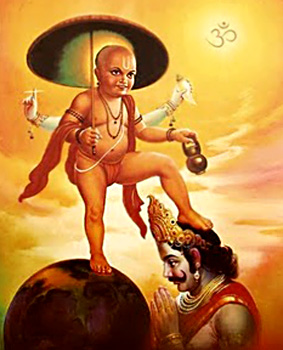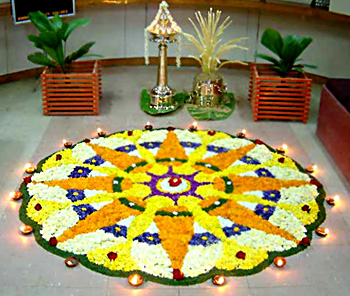 Mahabali is one of the most famous legendary kings of Kerala. King Bali or King Mahabali is a glowing example of how well-structured the traditions and history of the state of Kerala are with the mythology and religion of this Indian state. This renowned tale is a common recitation before adults and children to repeat as to why the Onam festival is celebrated. The people of Kerala are proud of origin of the festivals they celebrate. Onam is the great fertility rite of the year, the ceremony of gratitude for the never-failing fruits of a tropical climate, but it also a festival that reenacts one of the most important legends of the Malayali people. On the eve of Thiru Onam, the second day of the festival, ziggurat-like structures of flowers are placed in the entrances to houses of the people of Kerala; these are intended to welcome, on his annual return the following morning from the underworld, the legendary king Mahabali, who ruled over the Indian state of Kerala in the golden age before caste existed, when all men were equal no man was poor, and there was neither theft nor dread of thieves.
Mahabali is one of the most famous legendary kings of Kerala. King Bali or King Mahabali is a glowing example of how well-structured the traditions and history of the state of Kerala are with the mythology and religion of this Indian state. This renowned tale is a common recitation before adults and children to repeat as to why the Onam festival is celebrated. The people of Kerala are proud of origin of the festivals they celebrate. Onam is the great fertility rite of the year, the ceremony of gratitude for the never-failing fruits of a tropical climate, but it also a festival that reenacts one of the most important legends of the Malayali people. On the eve of Thiru Onam, the second day of the festival, ziggurat-like structures of flowers are placed in the entrances to houses of the people of Kerala; these are intended to welcome, on his annual return the following morning from the underworld, the legendary king Mahabali, who ruled over the Indian state of Kerala in the golden age before caste existed, when all men were equal no man was poor, and there was neither theft nor dread of thieves.
The story of Mahabali is a peculiarly Keralan and non brahminical adaptation of the story of the fifth incarnation of Lord Vishnu. In the orthodox version, which dates back to The Rig Veda, long before the cult of Vishnu reached South India, Mahabali appears as the demon king Bali, of the race of the Asuras, who becomes a yogi so powerful in his magic that he gains control over the earth, and even the gods feel themselves threatened. The Lord Vishnu is deputed to save the Brahminical deities from this titanic magician, and he assumes the form of the pathetically ugly and comical dwarf Vamana, who one day appears before Bali as a holy beggar and asks a boon - the gift of as much land as he can cover in three paces. When Bali unsuspiciously agrees, Vamana begins to stride, and even as he makes the first step he grows into a being so gigantic that in his three paces he encompasses the whole earth, and the demon king Bali is forced to retreat to the infernal region, the only kingdom that is left to him.
In Kerala the whole perspective of this ancient legend is changed, for Bali becomes Mahabali, the Great Bali, who ruled his realm so well that he aroused the jealousy rather than the fear of the gods, and who gave up his kingdom, not because he was the victim of a trick, but because he was too generous to refuse a request and too honourable not to fulfill a promise. As he withdrew into the underworld, victim of the malice of the gods, he asked one boon for himself, which was granted: that on a single day each year he might be allowed to return and to see how his beloved children, the Malayans, were faring. That day is Thiru Onam, and Mahabali`s ghostly but amiable presence is greeted by a special feast of boiled bananas and by the exchanging of gifts, while in the honour of the king the girls put on white skirts and coloured blouses, and dance with flowers in their hair. At the same time the Nairs, the traditional warrior caste of the Malabar Coast, stage sword-fights, and in the wide backwaters the young men race the great snake-boats, the chundan valloms, with their tall ornamental sterns and their hundred paddlers, whose very name and form look back to the age when the gods of the Brahmin were still unknown in Kerala and the people worshipped the Nagas, the serpent deities who lived, like King Mahabali, in the underworld.
 The story of Mahabali is a fragment of mythological history, representing the conquest of the native Dravidian culture by the advent of the Aryan teachers from the north who brought with them the Vedic religion and the Sanskrit language, and who imposed on southern India a caste system which had not existed before they came, but which has proved durable enough to be- devil the politics of Kerala even in the middle parts of the twentieth century. The legend, in other words, presents the Dravidian version of a great social transformation which took place before the historical record began, and this is one of the reasons why King Mahabali, despite the fact that he incurred the wrath of the great gods, is still affectionately remembered by the ordinary people of Kerala as a personification of the losing side in the struggle between cultures.
The story of Mahabali is a fragment of mythological history, representing the conquest of the native Dravidian culture by the advent of the Aryan teachers from the north who brought with them the Vedic religion and the Sanskrit language, and who imposed on southern India a caste system which had not existed before they came, but which has proved durable enough to be- devil the politics of Kerala even in the middle parts of the twentieth century. The legend, in other words, presents the Dravidian version of a great social transformation which took place before the historical record began, and this is one of the reasons why King Mahabali, despite the fact that he incurred the wrath of the great gods, is still affectionately remembered by the ordinary people of Kerala as a personification of the losing side in the struggle between cultures.
But there is another aspect to the Onam festival than either forgotten history it revives or the universal symbols of fertility with which it links Mahabali and his legend. To educated Malayalis - and that means a majority in a state which has long cherished the highest literacy rate in all India - Mahabali is no more figure of past or present reality than Santa Claus is to us. Yet they still celebrate his festival as richly as they can afford, partly because of the sentiments of brotherhood and good fellowship which the idea of Onam, like the idea of Christmas, generates, but also with an almost magical feeling that in some way what they do on the day when Mahabali returns may bring a gleam of his golden age into a time in which, for most Keralans, life shows its feet of clay.
This legend of the great Asura King Mahabali is a sequence from the Bhagavata. The moral of this great legend of Kerala is that the arrogance and pride always takes an individual to its downfall and this fight in between a very powerful conquering sovereign and a small boy with an umbrella can also be equated to the famous legend of David and Goliath, a well-known story from the Bible.






